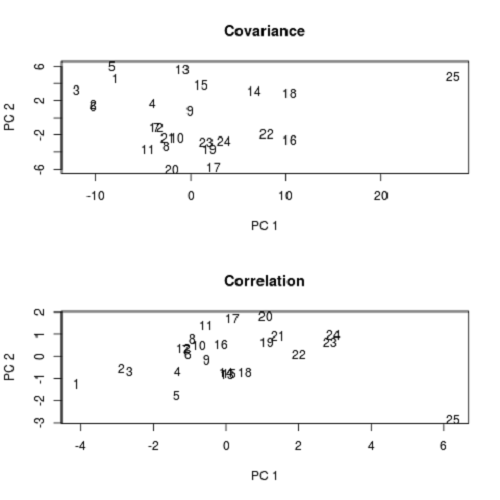Difference Between Covariance and Correlation

Covariance vs. Correlation
Covariance and correlation are two concepts in the field of probability and statistics. Both concepts describe the relationship between two variables. Additionally, both are tools of measurement of a certain kind of dependence between variables.
“Covariance” is defined as “the expected value of variations of two random variates from their expected values,” while “correlation” is “the expected value of two random variates.”
To simplify, a covariance tries to look into and measure how much variables change together. In this concept, both variables can change in the same way without indicating any relationship. Covariance is a measurement of strength or weakness of correlation between two or more sets of random variables, while correlation serves as a scaled version of a covariance.
Both covariance and correlation have distinctive types. Covariance can be classified as positive covariance (two variables tend to vary together) and negative covariance (one variable is above or below the expected value compared to another variable). On the other hand, correlation has three categories: positive, negative, or zero. Positive correlation is indicated by a plus sign, negative correlation by a negative sign, and uncorrelated variables – by a “0.”
Both covariance and correlation have ranges. Correlation values are in the scale of -1 to +1. In terms of covariance, values can exceed or can be outside of the correlation range. In addition, correlation values are dependent on units of measure of “X” and “Y.”
Another notable difference is that a correlation is dimensionless. In contrast, a covariance is described in units formed by multiplying the unit of one variable by another unit of another variable. Covariance focuses on the relationship between two entities, such as variables or sets of data. In contrast, correlation can involve two or more variables or data sets and the relationships between them.
Another notable distinction between the two is that a covariance is often in tandem with a variance (one of its properties, but also the common measure of scatter or dispersion), while correlation goes together with dependence and regression analysis. “Dependence” is defined as “any relationship between two data sets or random variables,” while regression analysis is the method used to investigate the relationship between independent and dependent variables. Other classifications of correlation are partial and multiple correlations.
Summary:
1.Covariance and correlation are two concepts in the study of statistics and probability. They are different in their definitions but closely related. Both concepts describe the relationship and measure the kind of dependence between two or more variables.
2.Covariance is the expected value of variation between two random variates from their expected values, while a correlation has almost the same definition, but it does not include variation.
3.Covariance is also a measure of two random variables that vary together. Meanwhile, correlation is associated with interdependence or association. Simply put, correlation is how far or how close two variables are from being independent of each other.
4.Covariance is a measure of a correlation, while correlation is a scaled version of covariance.
5.Covariance can involve the relationship between two variables or data sets, while correlation can involve the relationship between multiple variables as well.
6.Correlation values range from positive 1 to negative 1. On the other hand, covariance values can exceed this scale.
7.Both correlation and covariance employ a positive or negative description of their types. Covariance has two types – positive covariance (where two variables vary together) and negative covariance (where one variable is higher or lower than the other). In terms of correlation, positive and negative correlations are joined by an additional category, “0” – an uncorrelated type.
- Differences Between Fraternity And Sorority - January 8, 2014
- Differences Between Lucite and Plastic - January 7, 2014
- Differences Between Oil and Butter - January 6, 2014
Search DifferenceBetween.net :
Leave a Response
References :
[0]https://stats.stackexchange.com/questions/53/pca-on-correlation-or-covariance
